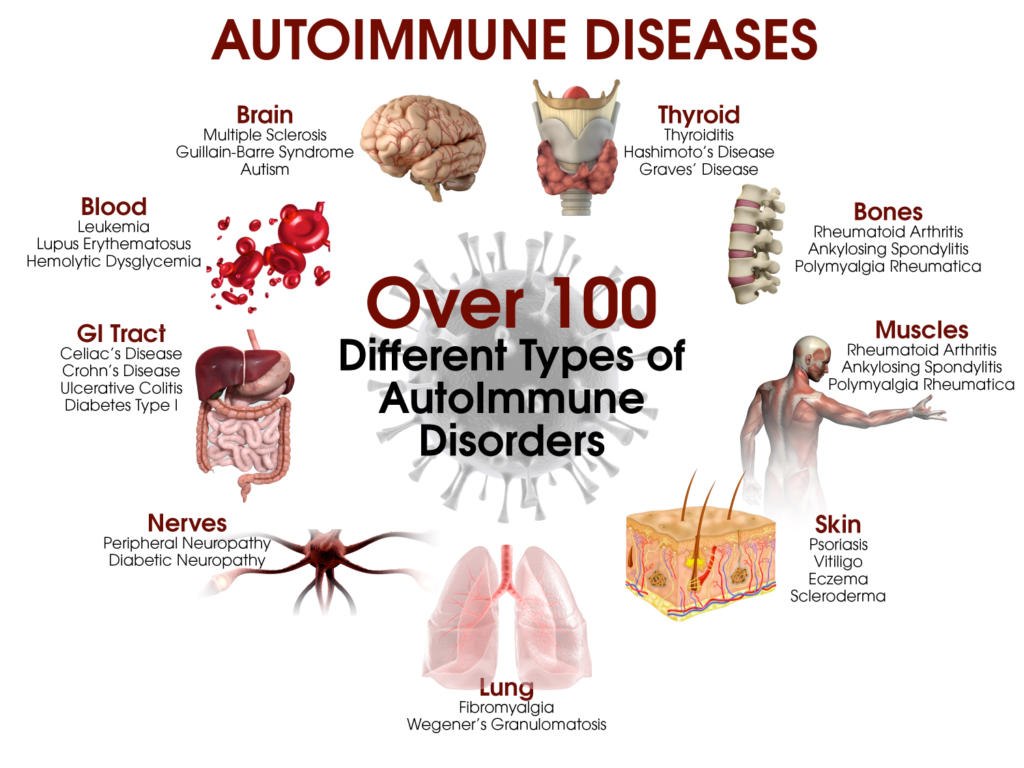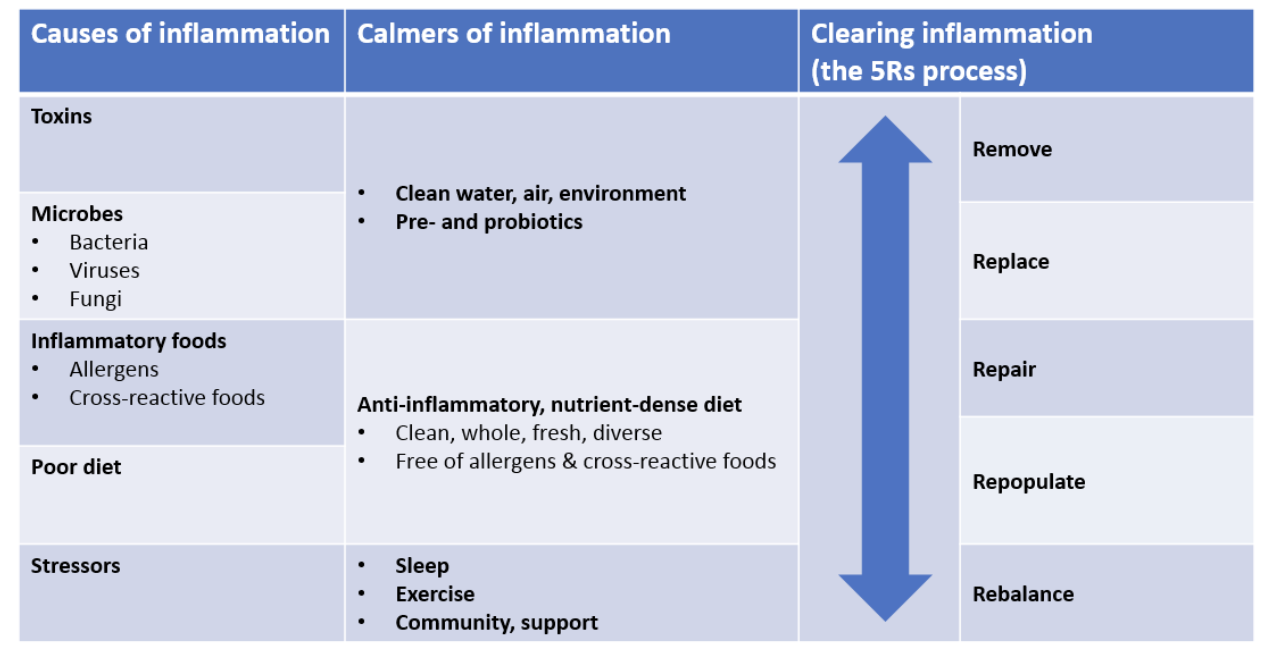We all want to know “the” cause and how to get a “cure” for autoimmunity. First, let’s look at the causes.
Genetics play a role:
“The exact cause of autoimmune disorders is unknown. One theory is that some microorganisms (such as bacteria or viruses) or drugs may trigger changes that confuse the immune system. This may happen more often in people who have genes that make them more prone to autoimmune disorders.” (9, NIH MedlinePlus)
Physicians agree that genes in combination with certain triggers each play a role:
“Autoimmune conditions are multifactorial in their cause, with a mixture of genetic and environmental factors often playing a role. As multifactorial conditions are partly caused by genetic factors, autoimmune conditions tend to run in families…However, genetically susceptible individuals do not always go on to develop an autoimmune condition.” (10, News-Medical.net)
Conventional medicine says that the causes of autoimmune diseases are unknown. Yet even conventionalists are now recognizing that, while:
“…in many cases, it appears that there is some inherited tendency to develop autoimmune diseases. In people with this inherited tendency, other factors such as infections and some drugs may play a role in triggering autoimmune disease.” (4, ASCIA)
Another example comes from The New England Journal of Medicine where, over 15 years ago, results were published from researchers who found that:
“…even in a genetically predisposed person, some trigger — an environmental exposure or a change in the internal environment — is usually required for frank autoreactivity” (11, NEJM) and by “autoreactivity” in this context they mean, for the autoimmune disease to turn on.

Dr. Amy Myers references this chart in her 2015 discussion in MindBodyGreen, “8 Myths and Facts About Autoimmune Disease”:

Dr. Myers goes on to say, “genetics does account for about 25% of the chance that you will develop an autoimmune disorder. But that means the remaining 75 percent of the picture is environmental — and therefore up to you. I find that an incredibly empowering statistic.”
So do we. This gives us hope, actually, in that our fates are not all predetermined by genes that we can do nothing about; rather, it tells us that even conventional physicians acknowledge that there are environmental factors that drive our disease and, it then stands to reason, we can manage those factors in conjunction with our individual composition to better manage our disease. That’s the basic premise of a functional medicine approach.
Dr. Amy Myers again: “Through diet, intestinal healing, and reducing your toxic burden, you can instruct your problematic genes to turn off again, thereby restoring your beleaguered immune system to health.”
To further underline the brightness of the horizon, it’s our firm belief that, as genetics and functional medicine continue to progress and become more accessible to everyday people, we may even be able to better protect our next generations to come, by identifying their risk factors early, and so preventing their exposure to possible triggers from the outset. What a leg up they’ll have, over us who are currently dealing with de-activating disease after the fact. It’s relieving to know that our offspring and our offspring’s offspring will suffer less than we do.
Triggers and what we can do about them
So here we are now, today, learning that there may be some identifiable triggers that functional medicine can show us in spite of conventional medicine’s claim that there are no clear causes of autoimmune disease. What does this mean? What triggers and causes are there, and what can we do about them?
This is the crux of functional medicine’s departure from a conventional, strictly pharmaceutical-dependent approach. Functional Medicine (FxM) practitioners ask, is it really logical that the disease just randomly turned on, or is there likely a driver? As Dr. Hyman asks:
“Do you just randomly wake up with an autoimmune disease? The answer is No. There are real causes that we have identified for autoimmune disease. In functional medicine there are basically 5 causes of all disease, and these causes interact with your genes, and with deficiencies or imbalances that you have in things that you need to thrive.” (2, Hyman)
In other words, yes, there may be a genetic predisposition to one presentation or another – DNA indicators may tell you about other risks, as well, that it’s valuable to know about in order to minimize other stressors on the body that can act as triggers – and then it’s the infections, drugs and, FxM practitioners believe, toxins as well as certain reactive and cross-reactive foods, that CAN be considered the causes of the onset of autoimmune disease, and certainly are triggers for it. These offending molecules in the body can trigger an immune response, either because they’re directly harmful – so the immune system is reacting appropriately, but is overloaded – or because the way they behave and/or their shape makes them look like something the immune system should attack, and so it does: if it’s one of those cross-reactive foods, for example, that makes your tissue look like an offender when it’s bound to your single-layer gut lining, your immune system will also accidentally attack you.
A key purpose of the healing-based approach is to identify causes that could be effecting this confusion in the immune system, and/or creating a total load that’s beyond its ability to manage. In those situations, regulatory T-cells are not shutting down an inflammatory response that was initially meant to be healing, and instead are creating their own problem.
Functional medicine practitioners agree that there are key drivers and healing components that, when cleared and introduced in the right balance, respectively, lead to good health. These common denominators are what form the “5Rs,” which are the steps necessary to clear and balance the body in order to calm inflammation and reverse or arrest the course of autoimmune progression, with minimal pharmaceutical intervention. There is a predominant focus on gut health in this construct. We include stress management, sleep, exercise and lifestyle adaption in the final phase. Some practitioners group ‘offenders’ and ‘healers’ into 4 groups; others, into 6, but the basic elements are the same. We use 5. These are:

We think it’s better for our overall health to eliminate the cause of the overactive -inflammatory response in the body than it is to block the inflammation with pharmaceuticals, while leaving the cause in place. This is Dr. Hyman’s “aspirin and tack” analogy:
“Conventional strategies like powerful immune-suppressing medication fail to address the underlying cause. That’s like taking a lot of aspirin while you are standing on a tack. The treatment is not to take more aspirin or a strong immune suppressant; it is to remove the tack. In conventional medicine, most of us were taught to diagnose disease by symptoms, NOT by their underlying cause. No matter what autoimmune disease you struggle with – and remember, they are just labels– I encourage you to dig deeper and address underlying causes. Again, I strongly encourage working with a Functional Medicine practitioner.” (2, Hyman)
Individualization
It takes a bit of detective work to find out which drivers are in motion for each individual. There’s the Overall Equation, of how these drivers interact with an individual, and then the Action Plan, which is what the functional medicine “5Rs” are designed to address through the gut and other lifestyle adjustments. In other words, Causes, Calmers, and Clearing are broad categories. Lab tests and informed interpretation of those tests lead the way to how these factors specifically apply to an individual.
The Causes, Calmers, and 5Rs Clearing process are known common denominators or “factors” in the multi-factorial autoimmune disease process. How they affect an individual requires an individualized discovery process.
So while practitioners have found, through many case studies, that there are certain common drivers known, such as gluten in the diet, pesticides and herbicides that cause problems, and that there are valuable health builders like a clean diet, key supplements, movement, and community that help you achieve the balance that enables your immune system to calm, you’ll want to find out whether there are individual factors that are affecting health, such as microbes (bacteria, viruses or fungi) out of balance, cross-reactive foods, hormonal imbalances, DNA predispositions, and the like. Your practitioner will help you discern the best tests for you to evaluate these areas to devise an individualized plan.
We like the “equation” outlined by Dr. Rudy Mueller, Certified IFM Functional Medicine Practitioner and DNA expert, who describes the total picture that forms an individual’s health as follows:
E + L + M + PE + G = Health
More specifically:
Environment + Lifestyle + Mindset + Past Experience + Genetics = Individual Health
You’ll learn more about each of these drivers as you work through the articles here in The Autoimmune Families Community, work with your practitioner, and gather your test results and observations.
We’ll leave you with the voice of just one more expert on autoimmunity: Dr. Tom O’Bryan. Dr. Tom O’Bryan is considered an expert on non-celiac gluten sensitivity. In recent years, and through summits he’s hosted on gluten sensitivity and other triggers of autoimmune disease, he’s interviewed a number of functional and natural medicine practitioners who are together forming a wider community and greater awareness about autoimmunity, its causes and triggers. Here’s an interview of Dr. O’Bryan on the subject; buckle in for a 35-minute but very accessible introduction.

